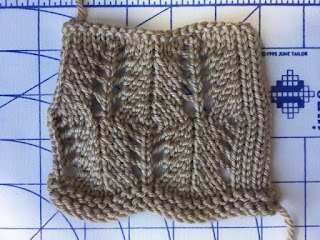The question was this: why did my machine knit swatches not look like the lace in the pattern when I followed the chart? In my previous post I said that I knit the machine knit and the hand knit swatches using the exact same chart provided in the Kohi Shawl pattern. For sure I did, but when I did the machine knit swatch I started the repeating pattern as I had highlighted it in the chart below on the left.

I did this so that I could pair up the decreases and increases so that when I made the first eyelet I would have a matching decrease (columns 14 and 11 in the photo) for the transfer to the right. A conscious decision, but not fully thought through as you will see.
When I did the hand knit swatch, I didn't "cherry pick" the start of the lace repeat, and instead just started at the bottom of the chart as you would. Here's an image of more of the chart, on the right, and the highlighted area on the bottom right of the image is the repeat I knit from. I had a theory now that changing the start point was what went wrong, so I went back and did one more hand knit swatch knitted from the top part of the chart and lo and behold, the bias is gone just like it was for the first two machine knit swatches.
The fact that the first eyelet has no matching decrease on the right, and the last decrease has no matching eyelet increase on the left, is the key to making the lace "wave", or bias. It does match up over the course of the row - the increases and decreases cancel each other out and you have the same number of stitches in work. But over the course of the first ten pattern rows (even-numbered rows are knit plain) the fabric biases one stitch to the right five times. Then on the next ten row repeat where you start with an orphaned decrease instead of increase, it biases in the opposite direction five times (or stitches) to keep everything balanced overall. On a knitting needle, you have the same number of stitches per row every row, and you happily work away. On the knitting machine, the actual needles in work on the bed have shifted over by five stitches to the right, and then in the next section five stitches to the left, and you're more likely to notice, and in my case, think something is perhaps wrong, because not only is the texture of the fabric "undulating", but so is your actual work space on the bed of the machine.
What that also means for the machine knitter is that you have to take into consideration this 5 stitch movement back and forth, and so for a 150-needle bed, as mine is, my maximum work space for this lace would be 145 needles.
Because there is quite a lot of hand manipulation involved in this pattern, and because it will be travelling back and forth five stitches on the machine bed, and finally because I don't like to over-complicate things (I see you rolling your eyes and laughing), I've decided that this shawl will be a wide rectangle. I've also decided that I'm going to try it on 69 stitches (9 stitch repeat 7 times, plus three edge stitches on each side). I decided on that by looking at the cast off edge on the first two shawls, which I know is almost 150 stitches wide, and that about half that would be a nice overall width. I haven't quite decided on the edging, so if anyone has any suggestions please leave them below in the comments.
In the meantime, I am reminded of Bob Ross, and his wise and liberating advice, to feel free in our creative pursuits to put a little tree here and a little stream there, where ever we feel like it.
Nancy









